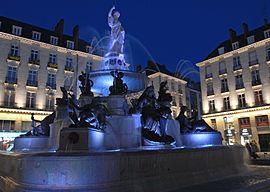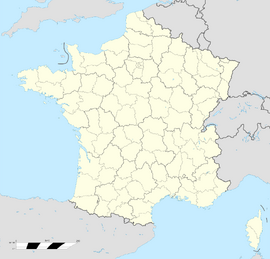| Main | Births etc |
|---|
| Nantes Naunnt |
|||
|---|---|---|---|
| Place Royale | |||
|
|||
| Motto: Latin: Favet Neptunus eunti ("Neptune favours the traveller") |
|||
| Coordinates: Coordinates: | |||
| Country | France | ||
| Region | Pays de la Loire | ||
| Department | Loire-Atlantique | ||
| Arrondissement | Nantes | ||
| Canton | Chief city of 11 cantons | ||
| Intercommunality | Nantes Métropole | ||
| Government | |||
| • Mayor (2014–2020) | Johanna Rolland (PS) | ||
| Area1 | 65.19 km2 (25.17 sq mi) | ||
| • Urban (2008) | 524.6 km2 (202.5 sq mi) | ||
| • Metro (1999) | 2,242.6 km2 (865.9 sq mi) | ||
| Population (2010 census)2 | 284,970 | ||
| • Rank | 6th in France | ||
| • Density | 4,400/km2 (11,000/sq mi) | ||
| • Urban (2010) | 600,502 | ||
| • Urban density | 1,100/km2 (3,000/sq mi) | ||
| • Metro (2010) | 873,133 | ||
| • Metro density | 390/km2 (1,000/sq mi) | ||
| Time zone | CET (GMT +1) | ||
| INSEE/Postal code | 44109 / 44000, 44100, 44200 and 44300 | ||
| Dialling codes | 02 | ||
| Website | nantes.fr (French) | ||
| 1 French Land Register data, which excludes lakes, ponds, glaciers > 1 km² (0.386 sq mi or 247 acres) and river estuaries. 2 Population without double counting: residents of multiple communes (e.g., students and military personnel) only counted once. | |||
Nantes (French pronunciation: [nɑ̃t]) (Breton: Naoned, Gallo: Naunnt) is a city in West France, located on the Loire River, 50 km (31 mi) from the Atlantic coast.[1] The city is the sixth largest in France, with a metropolitan area of about 900,000 inhabitants.[2]
Nantes is the capital city of the Pays de la Loire region and the Loire-Atlantique département and also the largest city in the Grand-Ouest, North western France in English. Together with Vannes, Rennes and Carhaix, it was one of the major cities of the historic province of Brittany, and the ancient Duchy of Brittany. Nantes is culturally Breton and still widely regarded as its capital city.[3]
The Nantes Tramway opened in 1985, a reversal of the trend of tramway closures that had been going on since the middle of the 20th century. The tramway system is one of the largest and busiest in France. The city also has a Busway line, an innovative and notable Bus Rapid Transit. Nantes is served by an international airport, Nantes Atlantique Airport and a major French railway station, the Gare de Nantes.
In 2004, Time named Nantes as "the most liveable city in Europe".[4] In 2010, Nantes was named a hub city for innovation in the Innovation Cities Index by innovation agency, 2thinknow.[5] The city was ranked 36th globally from 289 cities and 4th overall in France, behind Paris, Lyon and Strasbourg for innovation across multiple sectors of the economy.[6] As of 2013, Nantes holds the title of European Green Capital awarded by the European Commission[7] for its efforts to reduce air pollution and CO2 emissions, for its high quality and well-managed public transport system and for its biodiversity with 3,366 hectares of green spaces and several Natura 2000 zones which guarantee a protection of nature in the area.[8]
Euronantes is the city's Central business district, which is currently in development near Gare de Nantes and on Île de Nantes, offering by 2015 500,000 m2 of office space, retail space and upscale hotels. The district is served by Busway line 4 at Cité Internationale des congrès et Tripode stations.[9]
In 2012, Nantes was classified as a global city by the GAMMA GaWC ranking of Loughborough University in England. Nantes is the fourth highest-ranked French city (behind Paris, Lyon and Marseille) according to its classification. Nantes was ranked ahead of cities such as Porto, Florence, New Orleans, Hanover, and Genoa.
Etymology[]
The name Nantes, pronounced [nɑ̃t] in French, derives from that of its pre-Roman-era inhabitants, the Gaulish tribe known as the Namnetes, who founded a town there around 70 BC. The city was called Portus Namnetum during the Roman occupation that began in 56 BC. The inhabitants of Nantes are known in French as Nantais ([nɑ̃tɛ]).
Nantes' most common nickname is the Venice of the West (French: La Venise de l'Ouest, Breton: Venezia ar C'hornôg),[10] a name owing to its position on the river delta of the Loire, the Erdre, and the Sèvre.[11]
History[]

The Marité schooner anchored in the port of Nantes

L'île Feydeau
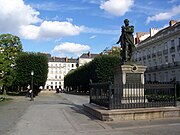
Cours Cambronne
Prehistory and Antiquity[]
Although there are very few prehistoric archaeological finds in Nantes and its surrounding area (in contrast to numerous ancient remains on the Breton coast), it seems the ancient population was based around mining communities in the north of the current town. During the Gallic period the area belonged to the Namnetes, who were conquered by Julius Caesar in 56 BC. The Romans Latinised the town's name to Condevincum, or Condevicnum, and under Roman rule it became an administrative centre. In the 3rd century it was renamed Portus Namnetum, and during this period a Gallo-Roman surrounding wall was constructed to fend off Saxon invasion; the remains can still be seen today. Nantes was Christianised during this period, and its first bishops took office after the conversion of Constantine the Great.
Middle Ages[]
After the fall of the Western Roman Empire in 476, the city rapidly came under the control of Clovis I despite resistance from the Roman garrison of Breton soldiers. During the Frankish period, the town played an essential role in halting Breton expansion from the Armorican peninsula. It became the capital of the 'Breton March' during the reign of Charlemagne; the territory was initially under the dominion of his nephew, Roland, who was given the title of 'Prefect of the Breton March'.
Breton Rule[]
After Charlemagne's death, Breton expansion intensified. In 850, the region was conquered by Nominoë, the ruler of Brittany, who invaded, among others, the towns of Nantes and Rennes. The following year, in the aftermath of the Battle of Jengland, the Breton March, with Nantes as its capital, was integrated into Brittany by the Treaty of Angers. The subsequent eighty years, however, were made difficult by the constant infighting between the Breton warlords, who promoted Viking invasions, the most spectacular of which took place on 24 June 843 and resulted in the death of Bishop Gohard of Nantes. The Chronicle of Nantes recounts that, during this period, "The city of Nantes remained for many years deserted, devastated and overgrown with briars and thorns." From 919 to 937, the town was managed by the Vikings, who were defeated by Alain Barbe-Torte, the grandson of Alan the Great, the last king of Brittany.[12][13]
The Wars of Succession[]

Timber frame houses in downtown
In the subsequent period, the Dukes of Brittany fought against the Counts of Nantes. These succession feuds resulted from time to time in Nantes passing under the sovereignty of the house of Anjou. The longest of these periods began in 1156 and lasted 45 years, representing a period of stability. In 1203 Brittany came under the dominion of the Capetians, the French monarchy, and under Peter I, Duke of Brittany Nantes enjoyed a resurgence when the Duke made the town his principal residence.
The Second Breton War of Succession pitted the supporters of two different claimants against one another: those of the half-brother of the deceased John III, Duke of Brittany, Jean de Montfort, who relied on the Estates of Brittany who gathered in Nantes, and those of Charles I, Duke of Brittany, who was supported by King Philippe VI of France and was recognized as Duke of Brittany by the peers of the kingdom. The De Montfort dynasty emerged victorious from the conflict, and it made Nantes an impressive capital of the duchy. During the 15th century the town developed, largely due to its maritime and river-based trade.
At the end of the 16th century, Nantes was of great strategic importance in the war between the King of France and Francis II, Duke of Brittany. The city was conquered in 1488, from which point Brittany was governed by the kings of France. The heir to the duchy, Anne of Brittany, married Charles VIII of France in 1491, and then Louis XII of France, making her Queen of France. At her death in 1514, she bequeathed her heart to the town of Nantes (currently in the Dobrée museum). Claude of France, the eldest daughter of Anne of Brittany, donated the duchy to her husband Francis I of France, but the Estates of Brittany themselves requested the union of Brittany and France in exchange for the continuation of their privileges, which ushered in the next period.
Union of Brittany and France[]

Maison des Apothicaires
In 1532 the duchy of Brittany became a part of the French crown lands, as a result of the Union of Brittany and France, an edict declaring a perpetual and indissoluble union between Brittany and France. Significantly, a resulting administrative reorganisation made the nearby city of Rennes the new seat of the Parlement of Brittany in 1560, increasing its role considerably. Nantes, however, retained the Chamber of the Counts of Brittany.
The union with France marked a period of relative growth for the port city. The town’s population increased from 15,000 inhabitants at the end of the 15th century to 25,000 at the end of the 16th century. The 2,000 boats which frequented the port exported wine and imported salt and cod.
Wars of Religion[]
During the Wars of Religion, Nantes supported the Catholic League and the governor of Brittany, the Duke of Mercoeur, in his fight against the Protestants. The town was one of the last to recognise the authority of Henri IV, which meant that the edict of Nantes, a decree guaranteeing the right of worship to Protestants, did not reflect the majority opinion of the inhabitants.
The year 1685 was dominated by two major events; the first being the revocation of the edict of Nantes by Louis XIV, and the second being the announcement of the Code Noir by the same king. The latter law ensured the prosperity of the port of Nantes, as it became a commercial hub where sugar, tobacco and slaves were traded with the colonies.
The Slave Trade[]
Nantes developed with the help of its foreign trade, which it inherited from the Middle Ages, and which it expanded during the era of colonists and white settlers who developed the colonial economy in the Antilles. The city's wealth, however, saw a far greater increase as a result of the slave trade in Africa, also known as the triangular trade. Although Nantes was not the only French port to have taken part in the slave trade (Bordeaux, Rouen, La Rochelle, Brest, Lorient and Vannes also sent expeditions), it certainly pioneered the trade: between 1707 and 1711, 75% of the ships carrying slaves were from Nantes. The principal ship-owners in Nantes were Michel, René and Jean Montaudoin, Luc Shiell, Marthurin Joubert, Jean Terrien and Sarrebouse d’Audeville. In 1754 the ship Saint-Phillipe, owned by the Nantes based Jogue brothers crossed the middle passage with 462 slaves in 25 days, whereas vessels earlier in the century would often take up to nine months. In the period between 1722 and 1744, Nantes was responsible for 50% of the human traffic, a percentage which grew again in 1762, before sinking to 32% between 1782 and 1792. In total, during the 18th century the port at Nantes sent out ships with 450,000 Africans, equivalent to 42% of the French slave trade. Nantes remained the principal slave port until the 1780s. Even after the official end of the slave trade in 1818, the trade continued. Over the next 13 years, 305 expeditions are recorded as having left from Nantes docks for the African coast.[14]
French Revolution[]
When the French Revolution broke out, Nantes supported the new government, in contrast to the surrounding region, which remained strongly loyal to the deposed royal family. Tensions soon escalated into an open civil war against the new republic known as the War in the Vendée. On 29 June 1793 the town was the site of a Republican victory in this war. The Loire was also the site of thousands of executions by drowning.[15]
Industrial Revolution[]
In the 19th century, Nantes became an industrial city. The first public transport anywhere may have been the omnibus service initiated in Nantes in 1826. It was soon imitated in Paris, London and New York. The first railways were built in 1851 and many industries were created.
Second World War[]
In 1940, the city was occupied by German troops. In 1941, the assassination of a German officer, Lt. Col. Fritz Hotz, caused the retaliatory execution of 48 civilians. The city was twice severely bombed by American forces, on 16 and 23 August 1943, before being liberated by the Americans in 1944.[16]
Post-war years[]
Until the 1970s, Nantes' harbour was located on the Île de Nantes, when it was moved to the very mouth of the Loire River, at Saint-Nazaire. In the subsequent 20 years, many service sector organisations moved into the area, but economic difficulties forced most of these to close. In 2001, a major redevelopment scheme was launched, the goal of which is to revitalise the island as the new city centre.[17]
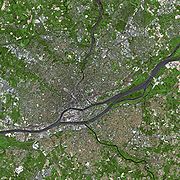
Nantes seen from Spot Satellite
In 2003, the French weekly L'Express voted Nantes to be the "greenest city" in France, while in both 2003 and 2004 it was voted the "best place to live" by the weekly Le Point. In August 2004, Time designated Nantes as "the most livable city in all of Europe."[4][18]
Geography[]
Nantes is located on the banks of the Loire River, at the confluence of the Erdre and the Sèvre Nantaise, 55 kilometres (34 miles) from the Atlantic Ocean. The city was built in a place where many branches of the Loire river created several islands, but most of those branches were filled in at the beginning of the 20th century (and the confluence with the Erdre river diverted and covered) due to the increasing car traffic.
Nantes is the central point of the land hemisphere (the half of the earth containing the largest possible area of land).
Climate[]
Nantes has a Western European oceanic climate, with frequent rainfalls all year round and cool temperatures. Autumn and winter days are generally rainy with cold temperatures often falling below zero and moderate snowfalls in the coldest months. Spring and summer days are sunny to cloudy with mild temperatures and occasional summer hot spells especially during the month of July.[19]
| Climate data for Nantes, Loire-Atlantique, France | |||||||||||||
|---|---|---|---|---|---|---|---|---|---|---|---|---|---|
| Month | Jan | Feb | Mar | Apr | May | Jun | Jul | Aug | Sep | Oct | Nov | Dec | Year |
| Average high °C (°F) | 9 (48) |
10 (50) |
12 (54) |
15 (59) |
18 (64) |
22 (72) |
24 (75) |
24 (75) |
22 (72) |
17 (63) |
12 (54) |
10 (50) |
16.3 (61.3) |
| Average low °C (°F) | 3 (37) |
3 (37) |
4 (39) |
6 (43) |
9 (48) |
12 (54) |
14 (57) |
13 (55) |
12 (54) |
9 (48) |
5 (41) |
3 (37) |
7.8 (46.0) |
| Precipitation mm (inches) | 91 (3.58) |
60 (2.36) |
74 (2.91) |
45 (1.77) |
61 (2.4) |
38 (1.5) |
39 (1.54) |
36 (1.42) |
65 (2.56) |
66 (2.6) |
84 (3.31) |
77 (3.03) |
736 (28.98) |
| Avg. precipitation days | 17 | 15 | 17 | 14 | 16 | 11 | 10 | 11 | 12 | 14 | 17 | 16 | 170 |
| Mean monthly sunshine hours | 71 | 98 | 149 | 186 | 211 | 240 | 267 | 239 | 192 | 140 | 90 | 71 | 1,954 |
| Source: Météo-France [20] | |||||||||||||
Politics[]

Tour Bretagne, the city's and one of France's tallest skyscrapers
Nantes is the préfecture (capital city) of both the Loire-Atlantique département and the Pays de la Loire région.
The Nantes metropolitan area (Nantes Métropole) is the intercommunal structure connecting the city of Nantes with nearby suburbs. It had a 1999 population of 554,478, 48.7% of which comprised the city of Nantes. The current mayor of Nantes is Johanna Rolland, (PS), elected on 04 April 2014. Over the years, and like most of Western France, Nantes has solidified itself as a Socialist stronghold.
Neighbourhoods[]

Château des Ducs de Bretagne's drawbridge and entrance
Since 1995, Nantes has been divided into 11 neighbourhoods, each resembling a historic city quarter. Each of these neighbourhoods is controlled by a Comité Consultatif (Consultative Committee), comprising directly elected officials and a team of municipal members, similar to a New England board of selectmen. These neighbourhoods are:
|
|
|
Nine of these neighbourhoods are situated on the right bank of the Loire, one is on the left bank, and one is on the Île de Nantes island.
Nantes and Brittany[]
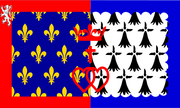
Flag of the Pays de la Loire
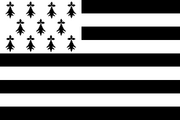
Flag of Brittany

Panoramic view of Nantes.
The city of Nantes, and the Loire-Atlantique département, were formerly part of the historic province of Brittany; Nantes was one of its traditional capitals, along with Rennes.[21]
Historically, the country around Nantes (French: Le Pays Nantais; Breton: Bro Naoned; Gallo: Paeï de Nàntt) was always seen as being part of Brittany. In 1207, the Dukes of Brittany made Nantes their home, building the Castle of the Dukes of Brittany on the banks of the Loire. Most of the dukes and duchesses were buried in either the cathedral or the nearby abbeys.
In 1789, the separation of the historical provinces of France resulted in Brittany being split in five; the lower of the five, Loire-Inférieure (today Loire-Atlantique) was where Nantes was situated. As such, Brittany as an administrative region did not exist during the 19th and early 20th centuries, although it did still exist culturally and informally.[22] When regional regroupments during the 20th century resulted in the reinstatement of the regions, Loire-Atlantique found itself split from the other four départements by the Vichy regime in 1941; a new région had been created centred on Nantes, the Pays de la Loire.
Much debate surrounding this move persists. Those against (sometimes called the Breton militants) maintain that the separation was made by a non-democratically elected government, and that Loire-Atlantique is culturally, historically and geographically united to Brittany; those in favour argue that any reunification would reopen a "quarrel of the capitals" between Nantes and Rennes, and that it would be fatal to the Pays de la Loire région.[23]
The issue of language is also relevant; in Upper Brittany (locally called Bretagne Gallèse or Haute Bretagne) Romance languages especially the local Gallo, as well as French, have long had more influence than Breton. However, in many large cities, including Nantes and Saint-Brieuc, the Breton language has sometimes been spoken more widely than Gallo by the very urban and bourgeois population there (even though in Le Pays Nantais the opposite was true). In recent years, many bilingual plaques have appeared on tourist attractions in the city, with the help of the Ofis ar Brezhoneg (French: Office de la Langue Bretonne; Office of the Breton Language).
Most recently, on 15 May 2004, a hastily organized demonstration in Nantes calling for the reunification of Brittany attracted 6,000 participants, while in five surveys on the issue, between 62% and 75% of the population of Loire-Atlantique have come out in favour of reunification.[24]
In 2008, 1.4% of the children in Nantes attended bilingual primary schools.[25]
Education[]
Colleges and universities[]
|
|
Transport[]
Public transport[]

The tramway in Nantes
The first organized omnibus transit system within a city appears to have originated in Nantes in 1826.[26] The Nantes Tramway originally began operation in 1879, but the first generation network closed in 1958. A new generation of tramway was re-introduced in 1985, and the current network is now one of the largest and most efficient in France.
The current network operated by Semitan includes three tramway lines, one Busway line, two Navibus lines, an extensive bus network with 56 lines, a night bus network and an airport shuttle bus labeled "Navette Aéroport" between downtown Nantes and Nantes Atlantique Airport. Additionally, Semitan has an exclusive agreement with French national train operator SNCF to allow TAN passengers ride suburban trains within the urban area limits with a valid TAN ticket or pass. Long distance travel throughout the Loire-Atlantique département is operated by Lila (run by the Loire-Atlantique council), which runs inter urban buses. All transport modes share a common ticketing system within Nantes Métrople (with the exception of Lila buses) and there are no travel zones on the TAN network and suburban trains (within the Métropole).[27]
Cycling[]

Bicloo bikes at Duchesse Anne station
The Nantes built-up area's inhabitants make about 2 million journeys a day. So as to ensure all its inhabitants of mobility while at the same time conserving its environment, Nantes Métropole provides efficient complementary modes of travel, public transport in particular. Furthermore, Nantes Métropole provides soft mode of transport: bicycles.
- Bicloo: 790 self-service bikes and 89 stations in central Nantes.
- City by bike: in partnership with NGE, rent a bike at the car parks.
- Velocampus: over 300 bikes for hire for students.
- The Loire Valley by bike: 240 km (149 mi) of continuous cycle tracks in the Pays-de-la-Loire.
- 376 km (234 mi) of cycle tracks.
Nantes Métropole is also taking part in the bid process of Velo-city 2015 under the guidance of the European Cyclist Federation.[28]
Railway[]
Nantes railway station lies on a number of rail lines. Nantes is connected by TGV (high speed train) to Paris, Lyon, Marseille, Lille, and Strasbourg, with trains to Paris via the LGV Atlantique taking just over 2 hours. By Corail, Nantes is connected to Quimper, La Rochelle, Bordeaux, Lyon, and Toulouse. The regional trains and buses of the TER Pays de la Loire provide links to Saint-Nazaire, Angers, Le Mans, La Roche sur Yon, and many other regional cities.
Harbor[]

Nantes Atlantique international airport
Nantes was formerly a major commercial harbor, with facilities on River Loire in Quai de la Fosse and the west side of the Île de Nantes in downtown. Much of the commercial traffic has since migrated downstream, principally to the area around Saint-Nazaire, although the river remains navigable to ocean-going ships as far as Nantes. River cruises operate on both the Loire and its tributary the Erdre. The Tan network also includes two urban water bus routes on both rivers known as Navibus.
Airport[]
Nantes Atlantique Airport, located 8 km (5 mi) to the south-west of the city center, serves the city and surrounding areas. It is the biggest airport in western France, linking with several French and European cities, as well as Montreal in Canada and some northern Africa cities. The planning of a larger airport Aéroport du Grand Ouest, that will be situated 30 km (19 mi) to the north-west of Nantes in the commune of Notre-Dame-des-Landes is subject to a controversy, the actual airport being far to be saturated and the new one destroying a wetland sheltering endangered species . The €580 million project keeps being delayed.[29]
Cityscape[]

Nantes Cathedral

Sainte-Croix church and its belfry

Thomas Dobrée museum

Château des Ducs de Bretagne seen from the courtyard
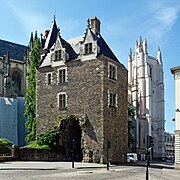
Porte Saint-Pierre facing place Maréchal Foch

Passage Pommeraye decorated for the Christmas period

Jardin des plantes of Nantes

Tour LU
Churches[]
Nantes has many churches, among which the most famous are:
- Cathédrale Saint-Pierre et Saint-Paul (colloquially called "Cathédrale Saint-Pierre").
- Église Notre-Dame de Bon-Port (also known as Basilica of Saint-Louis).
- Basilique Saint-Nicolas (Basilica of Saint-Nicolas, erected in 1844).
- Église Sainte-Croix (once designed as the chapel of Bouffay castle built during medieval times, then destroyed in the 19th century).
- Église Saint-Clément.
- Église Saint-Similien.
- Église Saint-Donatien et Saint-Rogatien.
- Église Saint-Félix (former bishop of Nantes).
- Église Sainte-Thérèse (made out of red bricks in its entirety).
- Église Saint-Pasquier.
Foreign worship places[]
- Saint-Basile-and-saint-Alexis orthodox church.
- Mosquée Arrahma
- Mosquée en langue turque
- Mosquée El Forkane de Nantes
Historical places[]
- Bouffay district, with its place Bouffay is the city's medieval and oldest district close to the castle and the cathedral.
- Place du Commerce, the city's main square with the Palais de la Bourse on it.
- Place Royale, a historical square with a large fountain in its center representing the Loire river.
- Place Graslin, a historic square featuring the Théâtre Graslin and world famous brasserie La Cigale.
- Place Général Mellinet.
- Place Maréchal Foch, a historical square with the statue of Louis XVI erected on a pillar in its center.
- Crebillon and Orleans streets, avenues lined with luxury boutiques linked to each other by Place Royale.
- Île Feydeau.
- Marché de Talensac (Talensac market), the oldest and main public market.
- Quai de la Fosse, the historical harbor of Nantes.
- The west part of Île de Nantes, a former shipyard turned into a leisure and cultural site including the Machines of the Isle of Nantes public attractions and some warehouses turned into bars, restaurants and night clubs.
- Quartier de la creation (creation district), on the Isle of Nantes close to the Machines of the Isle of Nantes.
Museums[]
- Musée d'histoire de Nantes (Nantes history museum), located inside the Château des Ducs de Bretagne.
- Musée d'Art de Nantes (Nantes' Art museum), reopening in 2018.
- Musée Thomas Dobrée (Thomas Dobrée archaeological museum), close to place Graslin and reopening in 2016.
- Muséum d'histoire naturelle de Nantes (Nantes' natural history museum) close to place Graslin and Thomas Dobrée museum.
- Musée Jules Verne, world famous novel writer Jules Verne's museum, on butte Sainte-Anne.
- Planetarium of Nantes, close to Jules Verne museum on butte Saint-Anne.
- Mémorial de l'abolition de l'esclavage (slavery abolition memorial), opened in March 2012. Nantes used to be France's main slave trading harbor, this memorial celebrates the ending of slavery.
- Musée naval Maillé-Brézé (naval museum).
- Musée des compagnons du devoir, the Pays de la Loire regional contemporary art collection located inside the "manoir de la Hautière" in Chantenay.
- Musée de l'imprimerie (print and typography museum).
- Musée de la Machine à coudre (sewing machine museum).
- Musée des sapeurs-pompiers (firefighters museum).
- Musée de la poste (post museum).
Monuments and landmarks[]
- Château des Ducs de Bretagne (castle of the Dukes of Brittany). The castle hosts the History Museum of the City of Nantes.
- Théâtre Graslin, an 18th-century theater and opera house.
- Porte Saint-Pierre, the best preserved remnant of the former battlements of the medieval city.
- Passage Pommeraye, built from 1841 to 1843 is a historical shopping mall on three levels.
- Maison des Apothicaires, a 15th-century timber frame large house.
- Couvent de la Visitation, a historical convent built in 1616.
- Historical Brasserie La Cigale, is an Art Nouveau designed brasserie opened in 1895, and described by Jean-Louis Trintignant as "perhaps the most beautiful brasserie in the world".[30]
- Tour LU, an Art Nouveau tower standing at the entrance of the former famous Lefèvre-Utile biscuit factory. Its twin tower was destroyed during the war.
- Cours Cambronne, a historical promenade garden close to place Graslin.
- Palais de la Bourse, the historical Nantes stock exchange which now houses a branch of FNAC.
- Sainte-Croix belfry, attached to Eglise Sainte-Croix.
- Tour Bretagne, a 37 stories office skyscraper built in 1976 in place Bretagne, which has become a popular landmark in the city. An observation deck is opened to visitors and offers a 360 degrees view of the city.
Parks and gardens[]
|
|
Leisure[]

Stade de la Beaujoire, home of FC Nantes of Ligue 1
- Stade de la Beaujoire, Nantes' largest sports stadium and home of FC Nantes football club.
- Parc des expositions de la Beaujoire, the city's exhibition center.
- La Cité Nantes Events Center.
Nantes has several cinemas including:
Arthouse cinemas:
- Katorza, close to place Graslin.
- Concorde, close to place Émile Zola.
- Le Cinématographe, the oldest cinema in Nantes.
- Bonne Garde.
- Beaulieu.
- Saint-Paul.
Multiplex cinemas:
- Gaumont Nantes, located on Place du Commerce.
- Pathé Atlantis, Nantes biggest cinema in the Atlantis commercial zone in Saint-Herblain.
- UGC Ciné Cité Atlantis in Saint-Herblain.
- Cinéville in Saint-Sébastien-sur-Loire.
- Ciné Pole Sud in Basse-Goulaine.
Concert halls[]
|
|
Culture[]

Picture of Theatre Graslin taken from the place that bears the same name

Museum d'Histoire Naturelle and its park on the front
Cultural events[]
Nantes hosts a variety of cultural events, among which:
- Estuaire, a contemporary art exhibition that takes place every two years between Nantes and Saint-Nazaire (along the Loire estuary).
- Les Rendez-vous de l'Erdre, a jazz festival centered around the Erdre river.
- Les rencontres du fleuve, a festival centered around ships and the river.
- Le Festival Eidos du film d'environnement et de développement durable, a cinema festival themed around the environment and sustainability.
- The Festival des trois continents, dedicated to African, Asian and South American cinema.
- La Folle Journée, a classical music festival,
- Les Utopiales, international science fiction convention,
- The Festival Voisinages, various theatre performances (Théâtre du Grand T, Théâtre universitaire de Nantes, salle Onyx de Saint-Herblain).
Music and artistic creation[]
There are quite a few bands from Nantes who play different genres but are not well known outside of France.
- The Celtic band Tri Yann was originally known as Tri Yann an Naoned (the three Johns from Nantes).
- The DJ group C2C, champion of the Disco Mix Club World Team DJ Championship four years in a row (2003–2006)[31] is native of Nantes.
- The Hip Hop group Hocus Pocus is from Nantes.
- 20-year-old electropop producer Madeon is a native of Nantes.
- Depth Affect is from Nantes.
To see a list of Bands from Nantes, see fr:Rock à Nantes (French).
Royal de Luxe street theater company, famous for its performance featuring giant puppets, is based in Nantes.
Local food[]
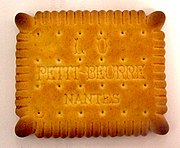
Petit beurre biscuit produced by LU

Berlingot candy
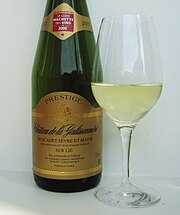
Muscadet wine
Specialties from Nantes include:
- Muscadet, a white French wine.
- Beurre blanc (white butter) also called "beurre Nantais" is a butter sauce created by Clémence Lefeuvre.
- Galettes, which are a heavier, less sweet version of the crepe, are traditional fare in Bretagne, the region in which Nantes historically resides. Galettes can be eaten at any time of the day, feature buckwheat flour, and are usually filled with meat, eggs, cheese, or a variety of other things. However, they are much less of a dessert food than the traditional crepes.
- Curé Nantais, a French cheese.
- Berlingot Nantais, a French candy created during the 19th century.
- Petit Beurre, a biscuit produced by LU.
Sport[]
The local football team is FC Nantes, members of the Championnat de France de Ligue 1 for the 2011–12 season. Since its creation in 1943, the club has gained reputation for its offensive style of play, locally named "jeu a la nantaise", and captured 8 Championnat titles and 3 Coupes de France.
Former players include Didier Deschamps, Marcel Desailly, Christian Karembeu and Fabien Barthez who were members of the France team that won the 1998 World Cup. Other notable players are Maxime Bossis, Philippe Gondet, Henri Michel, Claude Makélélé and Mickaël Landreau.
FC Nantes holds several records in the history of French professional football, including most consecutive seasons in the elite (44), most wins in a season (26), season invincibility (32 games) and all-time home invincibility (92 games, nearly 5 years). No French player has ever scored more goals than Philippe Gondet in a single season (36 in 1965–1966).
Media[]

Nantes seen from Erdre river
Local television channels[]
|
|
Radio stations[]
|
|
Local newspapers[]
Newspapers for sale:
|
|
Free newspapers:
|
Famous people[]
Statue of Anne of Brittany in front of the Château des Ducs de Bretagne
- Anne of Brittany, Duchess of Brittany and Queen of France (only woman to have married two kings of France, Charles VIII and Louis XII)
- François Bégaudeau, writer, journalist and actor
- Louis-Albert Bourgault-Ducoudray, composer and professor (Prix de Rome laureate)
- Claire Bretécher, cartoonist
- Aristide Briand, French statesman (1926 Nobel Peace Prize laureate)
- Claude Cahun (born Lucy Schwob), photographer and author
- Pierre Cambronne, general (commander of the Old Guard at Waterloo)
- Jacques Cassard, corsair
- Jeanne Cherhal, singer and songwriter
- Jacques Demy, movie director
- Jean Graton, cartoonist
- Linda Hardy, actress and model (Miss France 1992)
- Christophe-Léon-Louis Juchault de Lamoricière, general and politician (commander of the Papal army)
- Paul Ladmirault, composer
- Paul de la Gironière, traveler
- Denys de La Patellière, film director and scriptwriter
- Julien de Lallande Poydras, New Orleans member of the United States House of Representatives
- Charles-Auguste Lebourg, sculptor
- Hugo Leclercq aka Madeon, music producer
- Joseph Malègue, novelist
- Suzanne Malherbe (aka Marcel Moore), illustrator and designer
- Patrice Martin, water skier (12-time world champion)
- Anna Mouglalis, actress
- Jules Edouard Roiné, sculptor and medallist
- Benoit Regent, actor
- Claude Sérillon, journalist
- Éric Tabarly, sailor
- Sylvie Tellier, model (Miss France 2002)
- Jérémy Toulalan, football player
- Jules Verne, author
- Sandrine Voillet, art historian and television presenter
- Pierre Waldeck-Rousseau, politician
International relations[]
Twin towns – Sister cities[]
Nantes is twinned or has sister city relations with:
|
|
- Partnerships
The city has also built close ties with:
|
See also[]
References[]
- ^ Nantes Hutchinson Encyclopedia. Retrieved 14 August 2007.
- ^ Population des villes de France au dernier recensement PopulationData.net. Retrieved 14 August 2007
- ^ A New Luster in the Ancient Heart of Brittany The New York Times, 5 August 2007. Retrieved 7 August 2007.
- ^ a b The Last Best Place In Europe Time Europe, 22 August 2004. Retrieved 4 August 2007.
- ^ "Innovation Cities™ Top 100 Index » Innovation Cities Index & Program – City data training events from 2THINKNOW for USA Canada America Europe Asia Mid-East Australia". Innovation-cities.com. 1 September 2010. http://www.innovation-cities.com/innovation-cities-top-100-index-top-cities/. Retrieved 16 September 2011.
- ^ "Innovation Cities™ Global Index 2010 » Innovation Cities Index & Program – City data training events from 2THINKNOW for USA Canada America Europe Asia Mid-East Australia". Innovation-cities.com. 1 September 2010. http://www.innovation-cities.com/innovation-cities-global-index-2010-city-rankings/. Retrieved 16 September 2011.
- ^ "2013 – Nantes | European Green Capital". Ec.europa.eu. http://ec.europa.eu/environment/europeangreencapital/winning-cities/2013-nantes/index.html. Retrieved 2013-03-12.
- ^ Claire Iochum. "Energy Cities – Nantes – European Green Capital in 2013". Energy-cities.eu. http://www.energy-cities.eu/Nantes-European-Green-Capital-in. Retrieved 2013-03-12.
- ^ http://www.euronantes.com/en
- ^ The Venice of the West RugbyWorldCup.com. Retrieved 7 December 2007.
- ^ Blue Nantes FranceGuide.com. Retrieved 7 December 2007.
- ^ David C Douglas, ed. English Historical Documents (Routledge, 1979) "Secular Narrative Sources" pp 345f.
- ^ Chronicle of Nantes English Historical Documents. Dorthy Whitelock, David Charles Douglas. Routledge, 1996 ISBN 0-415-14366-7. Retrieved 30 October 2007.
- ^ group="Breaking the Silence, Learning about the Transatlantic Slave Trade website, is a joint initiative between UNESCO, Anti-Slavery International, the British Council and the Norwegian Agency for Development Co-operation (NORAD).">Smith, Zns. "Nantes Slave Port". http://old.antislavery.org/breakingthesilence/slave_routes/slave_routes_france.shtml. Retrieved 9 January 2013.
- ^ Ruth Scurr, Fatal Purity: Robespierre And the French Revolution (2006) p. 305
- ^ "tourisme/culture – France – Nantes – histoire page". reception. 22 October 1941. http://www.reception.com/US/nantes/histoire.htm. Retrieved 8 July 2009.
- ^ Revit Metropolitan Development
- ^ A recognized quality of life Business in Western France. Retrieved 4 August 2007.
- ^ Climate information for Nantes. Retrieved 8 September 2007.
- ^ "Normales, Pays de la Loire --> Nantes". Météo-France. http://climat.meteofrance.com/jsp/site/Portal.jsp?page_id=15872&CLIMAT_PORTLET.path=climatNormales/REG06. Retrieved 12 February 2013.
- ^ Presentation of Nantes CRWFlags.com. Published on 28-04-07. Retrieved 7 December 2007.
- ^ "Reviews of The Life and Science of Léon Foucault. The Man who Proved the Earth Rotates.". .phys.canterbury.ac.nz. http://www2.phys.canterbury.ac.nz/~wjt23/Horn.html. Retrieved 8 July 2009.
- ^ Loire-Atlantique guide
- ^ "Does the Breton language have a future?". Breizh.net. May 2004. http://www.breizh.net/icdbl/saozg/endangered.htm#Does%20the%20Breton%20language%20have%20a%20future. Retrieved 7 August 2007.
- ^ (French) Ofis ar Brezhoneg: Enseignement bilingue
- ^ Rodrigue, Dr. Jean-Paul. "Omnibus, Paris Late 19th century". Hofstra University. http://people.hofstra.edu/geotrans/eng/ch6en/conc6en/omni.html. Retrieved 9 August 2007.
- ^ Wansbeek, C.J. (January 2001). "Nantes expansion – City tram now a mature network". Tramways & Urban Transit (Ian Allan Ltd / Light Rail Transit Association). http://www.lrta.info/articles/art0101.html. Retrieved 9 August 2007.
- ^ "BID NANTES FRANCE VELO-CITY 2015". Blog.bid-nantes-france-velo-city2015.com. http://blog.bid-nantes-france-velo-city2015.com/. Retrieved 2013-03-12.
- ^ "New Notre Dame des Landes Airport, Nantes, France". airport-technology.com. http://www.airport-technology.com/projects/newnantes/. Retrieved 24 July 2008.
- ^ Birkin, Jane (9 February 2003). "My favourite table". The Observer. UK. http://shopping.guardian.co.uk/food/story/0,,889437,00.html. Retrieved 21 March 2008.
- ^ "DMC website". Dmcworld.com. http://www.dmcworld.com/championships/worldchampions/. Retrieved 13 April 2010.
- ^ Nantes Passion
- ^ Le Mois Nantais
- ^ Pulsomatic
- ^ La Lettre A Lulu
- ^ "British towns twinned with French towns". Archant Community Media Ltd. http://www.completefrance.com/language-culture/twin-towns. Retrieved 2013-07-11.
- ^ "Home page of Cardiff Council – Cardiff's twin cities". Cardiff Council. 15 June 2010. http://www.cardiff.gov.uk/content.asp?id=2940&d1=0. Retrieved 10 August 2010.
- ^ "Tbilisi Sister Cities". Tbilisi City Hall. Archived from the original on 2013-07-24. http://web.archive.org/web/20130724120155/http://www.tbilisi.gov.ge/index.php?lang_id=ENG&sec_id=4571. Retrieved 2013-08-05.
How arts turbo-charged a city: Liverpool Confidential
Further reading[]
- Published in the 19th century
- "Nantes". A handbook for travellers in France. London: John Murray. 1861. http://www.archive.org/stream/handbookfortrave1861john#page/160/mode/2up.
- C.B. Black (1876). "Nantes". Guide to the North of France. Edinburgh: Adam and Charles Black. http://www.archive.org/stream/guidetonorthfra01blacgoog#page/n578/mode/2up.
- "Nantes". Northern France. Leipsic: Karl Baedeker. 1899. OCLC 2229516. http://www26.us.archive.org/stream/northernfrance00karl#page/n365/mode/2up.
- Published in the 20th century
- "Nantes". Nantes (11th ed.). New York. 1910. OCLC 14782424. http://archive.org/stream/encyclopaediabri19chisrich#page/164/mode/2up.
External links[]
| Wikivoyage has a travel guide for Nantes. |
- Nantes : the former capital of Brittany – Official French website (English)
- Official website of the city of Nantes (French)
- Nantes tourism office official website (English)
- (TAN) Nantes public transports official website (French)
- Nantes Atlantique international airport website (English)
- Official website of Nantes' Castle (English)
- Photo Gallery of Nantes
- Local websites
- Nantes Metropole
- Nantes Métropole Développement
- La ville de Nantes
- Garde d'enfants à Nantes
- L'office de tourisme
- L'aéroport de Nantes
- Université de Nantes
| ||||||||
| |||||||||||||||||||||||||||
Template:Loire-Atlantique communes
| This page uses content from the English language Wikipedia. The original content was at Nantes. The list of authors can be seen in the page history. As with this Familypedia wiki, the content of Wikipedia is available under the Creative Commons License. |
